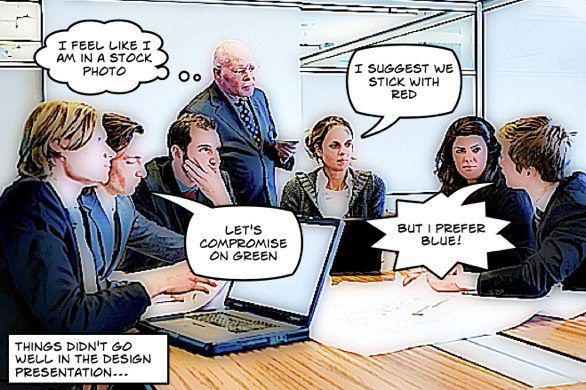At first, “design by committee” sounds like a positive thing, similar to collaboration. However, the term refers to design teams that have a difficult time compromising or making wise decisions. That results in a low-quality product. Design by committee occurs when there are multiple people – clients, design team members and/or stakeholders – with their own agenda and whose feedback has equal importance.
Design teams have to work together to turn out a product with a unified vision. Non-designers should stay out of important design decisions unless you’re surveying consumers who will be using the product. Even then, consumers aren’t always correct. There will also be people present in the meeting room who chime in just so they can contribute.
Problems with Design by Committee
Feedback is usually unhelpful when it comes from people who don’t have design experience. For example, even if someone has a good point about aesthetics, they may not understand how their suggestion decreases functionality. You shouldn’t let a client with no knowledge of design tell you how to do your job, and the same goes for non-design team members.
Furthermore, even though clients want to serve their customers, they often lose sight of that and worry about aesthetics or budget. To target user needs, the design team should be in the driver’s seat. They’ll keep the project on task when the client forgets why they’re doing what they’re doing.
Without focus, the design team can spend their time fixing problems that aren’t actually problems and following the advice of inexperienced people. This is the slippery slope of design by committee. They never get to focus on the aspects of the project that should take priority. This uses up the budget and the team members’ time when designing and when testing out flawed designs.
The final product will be of low quality, and when it’s criticized, no single person can be blamed. Instead, people will continue to point fingers until everyone looks like they failed. This causes a rift in the team and an unclear way to fix the issue so it doesn’t occur again.
6 Tips for Avoiding Design by Committee
You can still collaborate with the team while avoiding design by committee. Better communication means that team members will know which parts of the design process they are (and are not) included in, and misunderstandings will be avoided.
1. Get everyone on the same page from the start
Everyone should understand the goal(s) of the project, how information and suggestions are communicated, and the different ways that the client’s needs will be met. Also, if you see any eventual roadblocks, discuss them now instead of waiting.
Respectfully and clearly explain to the client that your team’s main goal is to find the best way to deliver a message and that if you come across feedback that prevents that from happening, you won’t be able to act on it. Also clarify that you’ll be collecting feedback from the audience. User testing is an excellent way to gain helpful feedback from the people who will be using the product.
2. Define team member roles
When each team member knows what their job is and what’s expected of them, they’re less likely to cross boundaries. While feedback from different team members, regardless of their role, will be considered, they’ll know that their suggestion may not be taken. You’ll also create a hierarchy when it comes to decision-making.
Every team should have a team manager who gathers feedback. The team manager also has the final say about what feedback is worthwhile and if it should be acted on now or later. Before presenting that feedback to the team, the manager will refine the feedback to be clear and actionable. To do all this, the team manager must have advanced design experience and in-depth knowledge of the product and market.
3. Create a process for providing feedback
Corral feedback so that it doesn’t come from too many places at once or threaten to take too much attention away from the project. Instead of letting anyone and everyone send an email or a Slack message when they have an idea, set designated times for sharing thoughts. There are many collaboration tools that let team members work and communicate in real-time. From there, the team manager will consider the feedback before taking action. Concerns that arise outside of designated times should be reported directly to the team manager.
4. Control the type of feedback that’s welcome and considered
Design teams need to work on behalf of the client and take their feedback to heart. However, professional designers are professionals for a reason, and they shouldn’t be required to compromise if it’s going to make the product inefficient. Steer what clients and team members provide feedback on, and manage expectations about what type of feedback will and will not be considered.
For example, product design should always align with the client’s guidelines and requirements. If a team member makes a suggestion that’s against the requirements, it will be immediately rejected. It can be harder to establish these boundaries with clients who are unfamiliar with the design process, which is where mockups, prototypes and wireframes come in handy. These tools can bridge the gap in communication, and the client will be able to see concepts that are difficult to explain.
5. Know how to present your design to the client
Avoid unhelpful client feedback by presenting the product to them in the most effective way. For example, if you put together a wireframe, the client will be able to see how the product functions. If you can, avoid presenting the client with several options. You know which design is best, and giving them too much to look at gives them control they shouldn’t have while making more work for you. If you’ve agreed to present options, present no more than three, and make it clear which one you think is strongest.
6. Regularly refer to the project’s parameters
To separate helpful feedback from unhelpful feedback, continually revisit the project’s goals and guidelines. Ask yourself, the client and the team questions like:
- Does the design reflect the brand’s personality?
- Is all of the necessary information included in the design?
- Have we included any information that isn’t necessary and that’s complicating or cluttering the design?
- Is this feedback coming from the individual’s personal preference or will it actually help meet the client’s objectives?
Wrapping Up
The products you make may be for your clients, but the work you put out is yours. It’s a reflection of your abilities and expertise, and you need it to be great to be successful. Clients hire designers for their expertise, and sometimes saying “no” to a client is doing what’s in their best interest, even if they don’t realize it yet.
Avoiding design by committee isn’t about ignoring the advice of everyone else involved in the project. It’s about collecting and deciphering that advice in a way that improves the project instead of muddles it. It’s also about relying on your expertise to guide you to make the best choices. Design teams should listen, consider and discuss feedback; make the decision that’s best for the project goal; and be ready to explain and defend that decision if questioned.
Want to learn more about running a successful project? Check out these 7 principles of risk management.
Featured image via Iconic Bestiary / shutterstock.com
The post 6 Ways to Avoid Design by Committee on Your Next Project appeared first on Elegant Themes Blog.

